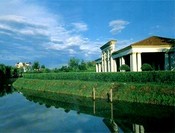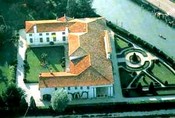Villa Barchessa Valmarana



|
The building that catches
the attention of visitors as they walk up to the fraction of Valmarana
on foot, leaving behind them, to the left, the famous "Casini
Valmarana", and continuing along a canal, is made up of two barchesse,
or wings. The barchessa on the right is also known as the lodge of
Villa Valmarana and was used by the family to host their guests from
abroad. The impact on visitors, as they walk up to the imposing portico
held up by strong Tuscan columns, is very powerful: at the centre
a beautiful carriage is visible that was built back in 1867 in sculpted
and engraved wood. On the outer side, in addition to the enormous
portico projected towards the river facing the building, special attention
must be attached to the Western façade which is also visible
from the Brenta when arriving from the direction of Padua: it recalls
a set of windows that clearly evoke the renaissance closed in between
the corner of the large portico and a mock portico on the opposite
side. Above the entrance arch one can see the coat of arms of the
Valmarana family. The Southern side had no monumental function, as
it could not be seen from the Brenta, and was thus very simple and
static with large windows that provided a lot of light to the inner
halls. Surrounding the building there is an Italian style garden and
an extensive park embellished by over a thousand rose bushes. The
tour of the villa includes the rooms facing the portico, all furnished
with original furniture from the 1700's. the first frescoed room
is called the "Sala dei Capricci", literally the hall of
fancy, and is decorated by oval monochromes depicting purple-tinted
fantastic views showing a landscape which is the fruit of the artist's
fantasy who toys with the imaginary and the real landscape that can
be seen from the nearby windows. Going through the door we enter into
the Ballroom that is wholly frescoed as was typical according to the
taste of the 1700's in the Veneto. The ceiling is dominated by
the glorification of the Valmarana family: at the centre one can admire
two female figures, one, in red, represents nobility and honour, whereas
the other, wearing a white drape, depicts the Valmarana family.
|
|

